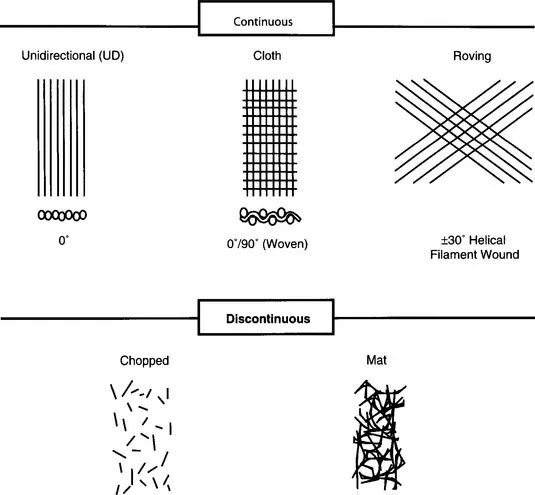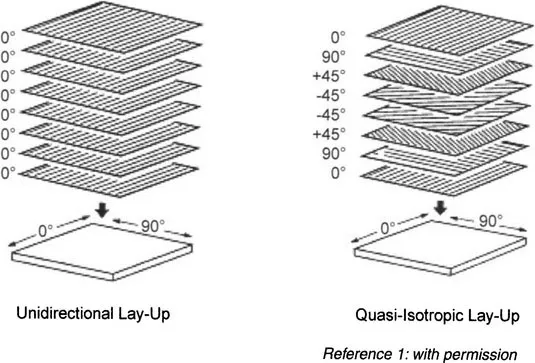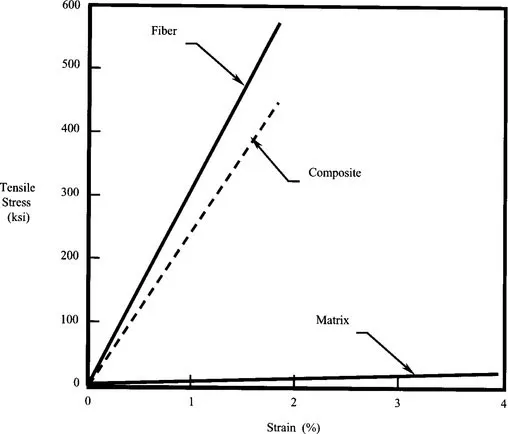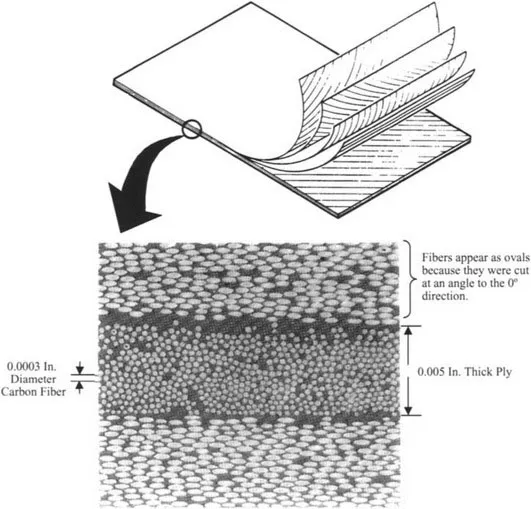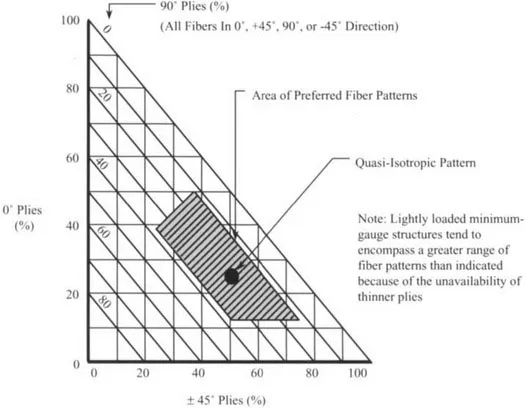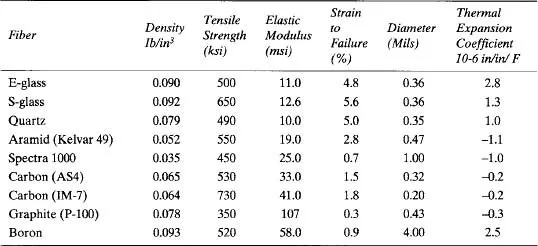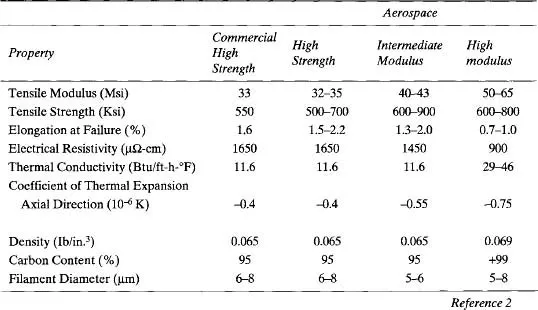1.1 Laminates
Continuous-fiber composites are laminated materials (Fig. 2) in which the individual layers, plies or laminae are oriented in directions that enhance the strength in the primary load direction. Unidirectional (0°) laminates are extremely strong and stiff in the 0° direction; however, they are also very weak in the 90° direction because the load must be carried by the much weaker polymeric matrix. While a high-strength fiber can have a tensile strength of 500 ksi or more, a typical polymeric matrix normally has a tensile strength of only 5–10 ksi (Fig. 3). The longitudinal tension and compression loads are carried by the fibers, while the matrix distributes the loads between the fibers in tension and stabilizes and prevents the fibers from buckling in compression. The matrix is also the primary load carrier for interlaminar shear (i.e., shear between the layers) and transverse (90°) tension. The relative roles of the fiber and the matrix in determining the mechanical properties are summarized in Table 1.
Table 1.1 Effect of Fiber and Matrix on Mechanical Properties
| Mechanical Property | Dominating Composite Constituent |
| | Fiber | Matrix |
| Unidirectional | | |
| 0° Tension | ✓ | |
| 0° Compression | ✓ | ✓ |
| Shear | | ✓ |
| 90° Tension | | ✓ |
| Laminate | | |
| Tension | ✓ | |
| Compression | ✓ | ✓ |
| In-Plane Shear | ✓ | |
| Interlaminar Shear | | ✓ |
Since the fiber orientation directly impacts the mechanical properties, it would seem logical to orient as many layers as possible in the main load-carrying direction. While this approach may work for some structures, it is usually necessary to balance the load-carrying capability in a number of different directions, such as the 0°, +45°, −45° and 90° directions. Fig. 4 shows a photomicrograph of a cross-plied continuous carbon fiber reinforcement in an epoxy resin matrix. A balanced laminate with equal numbers of plies in the 0°, +45°, −45° and 90° directions is called a quasi-isotropic laminate, since it carries equal loads in all four directions. Fig. 5 provides a graphical presentation of the preferred laminate orientations. These are preferred orientations because they are fairly balanced laminates that carry loads in multiple directions.
1.2 Fibers
The primary role of the fibers is to provide strength and stiffness. However, as a class, high-strength fibers are brittle; posses linear stress-strain behavior with little or no evidence of yielding; have a low strain to failure (1–2% for carbon); and exhibit larger variations in strength than metals. Table 2 presents a summary of the major composite reinforcing fibers.
Glass fibers are the most widely used reinforcement due to their good balance of mechanical properties and low cost. E-glass, or “electrical” glass, is the most common glass fiber and is used extensively in commercial composite products. E-glass is a low-cost, high-density, low-modulus fiber that has good corrosion resistance and good handling characteristics. S-2 glass, or “structural” glass, was developed in response to the need for a higher-strength fiber for filament-wound pressure vessels and solid rocket motor casings. Its density value, performance level and cost lie between those of E-glass and carbon. Quartz fiber is used in many electrical applications due to its low dielectric constant; however, it is very expensive.
Aramid fiber (e.g., Kevlar) is an extremely tough organic fiber with low density, and exhibits excellent damage tolerance. Although it has a high tensile strength, it performs poorly under compression. It is also sensitive to ultraviolet light and its use should be limited to long-term service at temperatures less than 350 °F.
Another organic fiber is made from ultrahigh molecular weight polyethylene (UHMWPE; e.g., Spectra). It has a low density with excellent radar transparency and a low dielectric constant. Due to its low density, it exhibits very high specific strength and modulus at room temperature. However, being a polyethylene its use is limited to within 290 °F. Like aramid, Spectra has excellent impact resistance; however, poor adhesion to the matrix is a problem, although plasma treatments can be employed to improve the adhesion.
Carbon fiber contains the best combination of properties but is also more expensive than either glass or aramid. It has a low density, a low coefficient of thermal expansion (CTE) and is conductive. It is structurally very efficient and exhibits excellent fatigue resistance. It is also brittle (strain-to-failure less than 2%) and exhibits low impact resistance. Being conductive, it causes galvanic corrosion if placed in direct contact with aluminum. Carbon fiber is available in a wide range of strength (300–1000 ksi) and stiffness (modulus 30–145 msi). With this wide range of properties, carbon fibers (Table 3) are frequently classified as: (1) high-strength, (2) intermediate-modulus or (3) high-modulus fibers.
The terms carbon and graphite are often used to describe the same material. However, carbon fibers contain ~95% carbon and are carbonized at 1800–2700 °F, while graphite fibers contain ~99% carbon and are first carbonized and then graphitized at temperatures between 3600 °F and 5500 °F. In general, the graphitization process results in a fiber with a higher modulus. Carbon and graphite fibers are made from rayon, polyacrylonitrile (PAN) or petroleum-based pitch. PAN-based fibers produce the best combination of properties. Rayon was developed as a precursor prior to PAN but is rarely used today, due to its higher cost and lower yield. Petroleum-based pitch fibers were also developed as a lower cost alternative to PAN but are mainly used to produce high- and ultra-high-modulus graphite fibers. Both carbon and graphite fibers are produced as untwisted bundles called tows. Common tow sizes are 1k, 3k, 6k, 12k and 24k, where k = 1000 ...

